Description
Signs and pavement markings create the basic elements of a bicycle boulevard. They indicate that a roadway is intended as a shared, slow street, and reinforce the intention of priority for bicyclists along a given route. Signs and pavement markings alone do not create a safe and effective bicycle boulevard, but act as reinforcements to other traffic calming and operational changes made to the roadway.
There are three applications for signing and markings on bicycle boulevards:
- Modified street signs identify and brand the route without introducing a new sign. A bicycle symbol can be placed on a standard road sign, along with the coloration associated with the bicycle boulevard network. These are commonly used in tandem with pavement markings.
- Pavement markings identify the route as a bicycle boulevard and can guide users through jogs. These vary throughout North America from small dots about a foot across to stencils that take up nearly a full lane at 30 feet by 6 feet. Several jurisdictions are using MUTCD-approved shared lane markings on bicycle boulevards for consistency with the rest of the bicycle network and because they are visible and proven to impact desired lane positioning by bicyclists. Read More+
Portland, OR, Madison, WI, Nampa, ID, and Wilmington, NC, use standard shared lane markings on their neighborhood greenways/bicycle boulevards. Tacoma, WA, is adjusting the standard marking to include a colored flag and modified bicyclist.
- Wayfinding signs also guide users through jogs, help brand the network, and include information about the route by identifying intersecting bikeways and providing distance/time information to nearby or popular destinations. Since few businesses or services are typically located along local streets, wayfinding signs inform users of the direction and distance to key destinations, including neighborhoods, commercial districts, transit hubs, schools and universities, and connecting bikeways.
Click on the images below to view 3D concepts of basic bicycle boulevard signs and pavement markings.
Treatment details can be accessed below under design guidance.
Benefits
- Signs and pavement markings help users remain on the designated route as it turns.
- Signs and markings differentiate bicycle boulevards from other local streets, indicating good routes for people bicycling and reminding people driving to watch for bicyclists.
- Signs and markings brand the bicycle boulevard to raise awareness of the designated routes and to encourage new users.
- Pavement markings encourage people on bicycles to properly position themselves in the roadway and reinforce to all users where bicyclists should be riding, promoting a more comfortable shared use environment for all users.
- Wayfinding signs provide information about nearby destinations and route finding, improving confidence for people bicycling in a new area.
Typical Applications
- Along all bicycle boulevards.
- At intersections where the bicycle boulevard crosses another bikeway or ‘jogs’ (turns onto another street).
Design Guidance
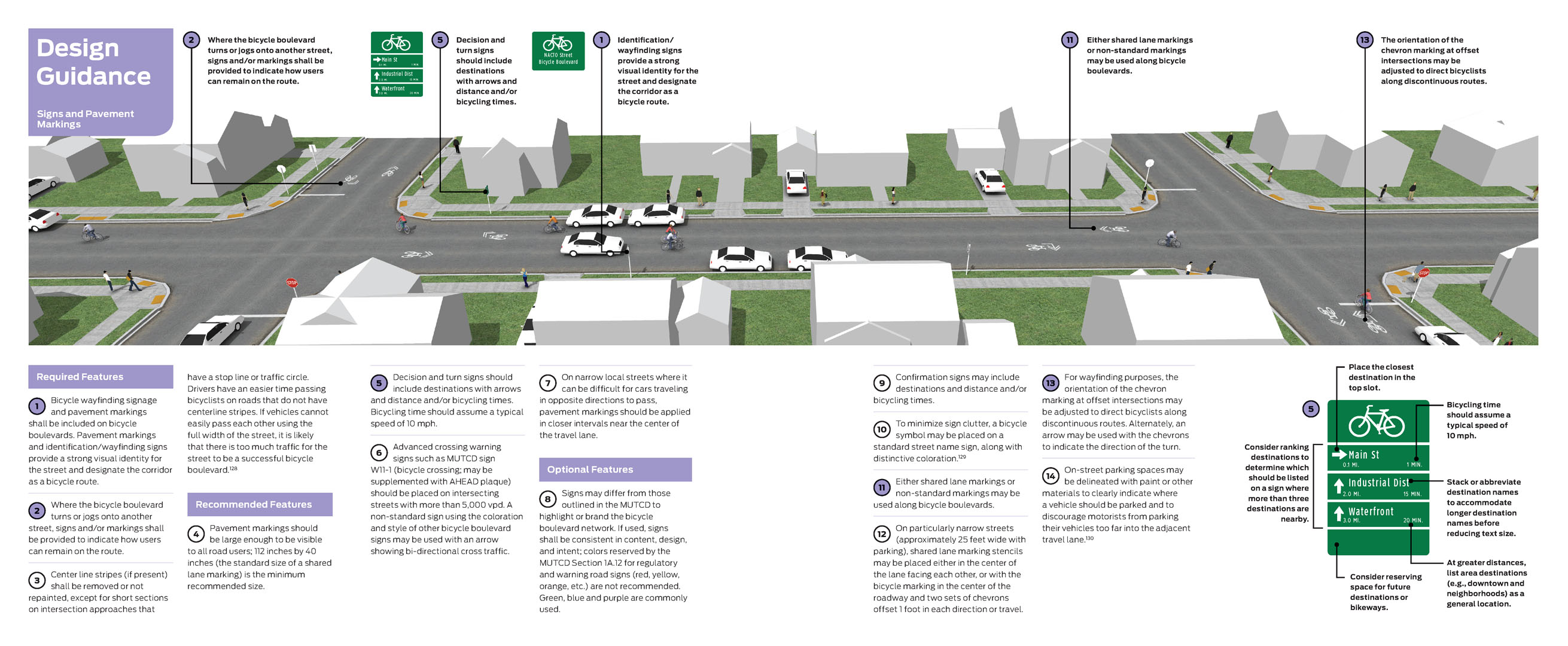
Click the image above to see the guidance summary page full screen.
See shared lane markings guidance for additional information on the placement and frequency of shared lane markings.
See bike route wayfinding signage and markings system for guidance on the use of directional pavement markings and wayfinding signs. Some cities have developed unique logos or colors that help brand the wayfinding signs. The MUTCD provides guidance for use of standard shared lane markings and wayfinding signs along bicycle routes.
Use of pavement markings and signs specifically for bicycle boulevards is discussed below.
| Required Features |
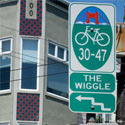 |
Bicycle wayfinding signage and pavement markings shall be included on bicycle boulevards. Pavement markings and identification/wayfinding signs provide a strong visual identity for the street and designate the corridor as a bicycle route. |
 |
Where the bicycle boulevard turns or jogs onto another street, signs and/or markings shall be provided to indicate how users can remain on the route. |
 |
Center line stripes (if present) shall be removed or not repainted, except for short sections on intersection approaches that have a stop line or traffic circle. Drivers have an easier time passing bicyclists on roads that do not have centerline stripes. If vehicles cannot easily pass each other using the full width of the street, it is likely that there is too much traffic for the street to be a successful bicycle boulevard.
Read More+
“Center line markings should be placed on paved urban arterials and collectors that have a traveled way of 20 feet or more in width and an ADT of 4,000 vehicles per day or greater.”
Federal Highway Administration. (2009). Manual on Uniform Traffic Control Devices. 3B.01.
“On roadways without continuous center line pavement markings, short sections may be marked with center line pavement markings to control the position of traffic at specific locations.”
Federal Highway Administration. (2009). Manual on Uniform Traffic Control Devices. 3B.01.
|
| Recommended Features |
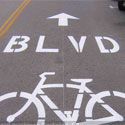 |
Pavement markings should be large enough to be visible to all road users; 112 inches by 40 inches (the standard size of a shared lane marking) is the minimum recommended size. |
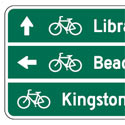 |
Decision and turn signs should include destinations with arrows and distance and/or bicycling times. Bicycling time should assume a typical speed of 10 mph. |
 |
Advanced crossing warning signs such as MUTCD sign W11-1 (bicycle crossing; may be supplemented with AHEAD plaque) should be placed on intersecting streets with more than 5,000 vpd. A non-standard sign using the coloration and style of other bicycle boulevard signs may be used with an arrow showing bi-directional cross traffic. |
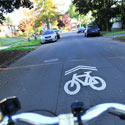 |
On narrow local streets where it can be difficult for cars traveling in opposite directions to pass, pavement markings should be applied in closer intervals near the center of the travel lane. |
| Optional Features |
 |
Signs may differ from those outlined in the MUTCD to highlight or brand the bicycle boulevard network. If used, signs shall be consistent in content, design, and intent; colors reserved by the MUTCD Section 1A.12 for regulatory and warning road signs (red, yellow, orange, etc.) are not recommended. Green, blue and purple are commonly used. |
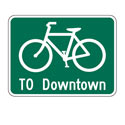 |
Confirmation signs may include destinations and distance and/or bicycling times. |
 |
To minimize sign clutter, a bicycle symbol may be placed on a standard street name sign, along with distinctive coloration.
Read More+
“A pictograph (see definition in Section 1A.13) may be used on a D3-1 sign. If a pictograph is used on a D3-1 sign, the height and width of the pictograph shall not exceed the upper-case letter height of the principal legend of the sign. The pictograph should be positioned to the left of the street name.”
Federal Highway Administration. (2009). Manual on Uniform Traffic Control Devices. 2D.42.
|
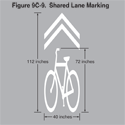 |
Either shared lane markings or non-standard markings may be used along bicycle boulevards. |
 |
On particularly narrow streets (approximately 25 feet wide with parking), shared lane marking stencils may be placed either in the center of the lane facing each other, or with the bicycle marking in the center of the roadway and two sets of chevrons offset 1 foot in each direction or travel. |
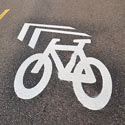 |
For wayfinding purposes, the orientation of the chevron marking at offset intersections may be adjusted to direct bicyclists along discontinuous routes. Alternately, an arrow may be used with the chevrons to indicate the direction of the turn. |
 |
On-street parking spaces may be delineated with paint or other materials to clearly indicate where a vehicle should be parked and to discourage motorists from parking their vehicles too far into the adjacent travel lane. Read More+
“Parking space markings tend to prevent encroachment into fire hydrant zones, bus stops, loading zones, approaches to intersections, curb ramps, and clearance spaces for islands and other zones where parking is restricted.”
Federal Highway Administration. (2009). Manual on Uniform Traffic Control Devices. 3B.19.
|
Maintenance
- Maintenance needs for bicycle signs are similar to other signs. Signs will need periodic replacement due to wear.
- The shared lane marking may be placed in the center of the lane between wheel treads to minimize wear.
Treatment Adoption and Professional Consensus
Shared lane markings and bicycle wayfinding signs were adopted as part of the 2009 MUTCD.
- The use of pavement markings to indicate turns and jogs is being tested in Columbus, MO and is used in Portland, OR.
- Minneapolis, MN, Berkeley, CA, and Vancouver, BC, use a modified street name sign with distinctive coloration and a bicycle symbol to indicate bicycle boulevards.